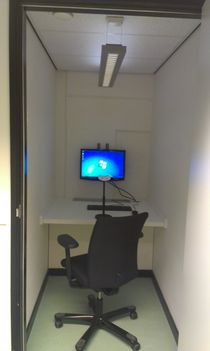Difference between revisions of "Behavioral Lab (K2F-71)"
| Line 7: | Line 7: | ||
Below find information regarding all devices used in the lab. If you need something that is not in the list, ask the Helpdesk whether they have it in store. | Below find information regarding all devices used in the lab. If you need something that is not in the list, ask the Helpdesk whether they have it in store. | ||
| − | *Computers | + | *[[Computers]] |
| − | *Software | + | *[[Software]] |
===Computers=== | ===Computers=== | ||
Revision as of 10:02, 9 October 2013
In this lab, there are 6 identical cubicles. In each of them, the distance between monitor and edge of the working space is 70 cm in general. Chin rests are available as well.
Facilities
Below find information regarding all devices used in the lab. If you need something that is not in the list, ask the Helpdesk whether they have it in store.
Computers
In each cubicle there is a HP Compaq 8000 Elite Small Form Factor with following specs:
- Processor: Intel(R) Core (TM) 2 Duo CPU E8400 @ 3.00GHz
- Graphics: NVIDIA GeForce 210
- OS:Windows XP Service Pack 3
For more information look here
Software
Each of the listed software is installed on every machine in the lab.
Monitors
Samsung Syncmaster 2233RZ
- Width: 47.5 cm
- Vertical visual angle: 37.48°
- Height: 30 cm
- Horizontal visual angle: 24.19°
- Diagonal: 56.2 cm
- Refresh rate: 120 Hz
- Distance to the screen: 70 cm
- Display resolution: 1680 x 1050
- ~ 45 Pixels per 1° horizontal visual angle
- ~ 43 Pixels per 1° vertical visual angle
NOTE: All monitors are set in a way that won't scale experiments to full screen. In this sense, all experiments will run exactly in resolutation that was specified in the program code.
Further information:
http://www.samsung.com/uk/consumer/pc-peripherals/monitors/gaming/LS22CMFKFV/EN-spec
Last calibration: 02-10-2013
Head phones
Currently, there are 3 pairs of Sennheiser HD 202 in the lab. If more are needed, contact the helpdesk. Besides, there are some other models of headphones in the lab, but only single pieces.
Miscellaneous
- tactile stimulating devices
- Stero Tac Usb SrBox with 2 outputs
- Mono Tac Usb SrBox with 1 output
- SrBox with response wheel
- JSP Monza hearing protectors
- (at least) 2 Genius Multimedia microphones MIC-01A (not stored in the lab, but in the helpdesk!)
- Sensitivity: -62dB +/- 4dB (at 1 kHz)
- Frequency response: 100 Hz to 10kHz
- S/N ratio: >40dB (at 1kHz)
- chin rests
Maintenance
Guideline monitor configuration
Steps for calibrating a monitor with the Lacie Blue Eye Pro.
- Make sure the screen has been on (not in sleep mode!) for a while (30 min.) and thus is warmed up.
- Plug in the calibration device in a USB port, and place it in the middle of the screen, which you can tilt backwards so the device stays better in place.
- Start the Lacie Blue Eye Pro calibration software.
- Click Settings, make sure the following settings are selected:
- Gamma: 2.2
- White point: predefined; 6500K
- Luminance: absolute; 120
- Click Calibration in bottom right corner.
- Before calibration will start, you get the possibility to adjust brightness, contrast and color directly on the monitor. These steps are not really necessary and can be skipped, as the calibration process will usually correct for this anyway. However, if you discover that the calibration process does not result in the desired values (e.g. a white point lower or higher than 120 cd/m2), you should play around with the monitor settings to get as close to the desired values (see step 4) as you can. For now: click next three times.
- You will get an overview of the settings with which the monitor will be calibrated. Click Start Calibration to begin with the calibration.
- Sit back and relax till the calibration is finished. This can take 5-10 min. Click save once it’s done.
- Click Test and report and wait till the measurements are done. Check if the reported devations of gamma, white point and color temperature are less than 2% and the reported dE values depicted on the right (the graph with the colored bars) are all well below 3. If the white point deviates more than 2% from 120 cd/m2, you should play around with the brightness and contrast settings for the monitor and recalibrate to get this right. Always run a test and report after a calibration, to determine if the screen emits the desired values for gamma, color temperature and white point.
Further reads:
http://www.tftcentral.co.uk/articles/calibrating.htm
